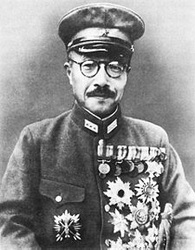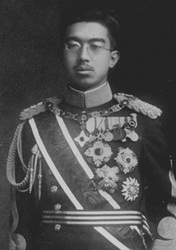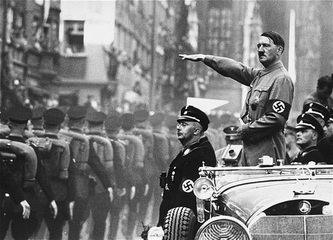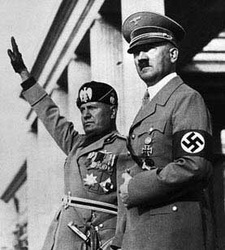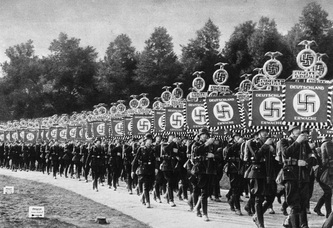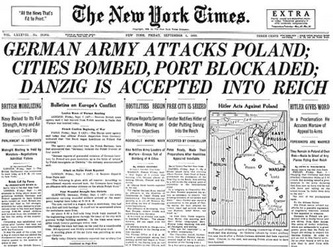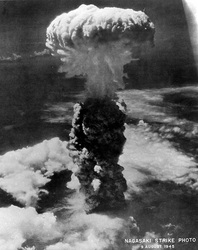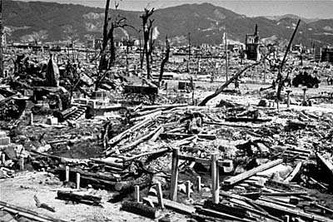RECOVERY
World War II
The War:
After World War I (1914-1918), unresolved conflicts during the interwar period augmented nationalistic, racist, and militarisitic attitudes within the Axis powers (Germany, Italy, and Japan). Under the terms of peace treaty that had ended the First World War, the Treaty of Versailles, Germany was beset by enormous reparations of 269 billion gold marks and was solely held accountable for causing the war in Article 231, the "War Guilt" clause. Italy had fought in the war on the side of the Allied powers (U.S.A., France, Great Britain) but did not receive any territory as compensation. After two decades of severe economic depression and public vehemance towards the Treaty of Versailles, both Germany and France turned to fascist dictators for solutions to their crises. Adolf Hitler and his National Socialist German Workers' Party (the Nazi Party) dominated the German government, while Benito Mussolini and his Fascist Party seized control of the Italian government. In the meantime, Japan steadily gained stature as a colonial power in the Pacific after World War I. The Japanese advocated uniting all of Asia under the Japanese emperor, known as the philosophy of hakkô ichiu (all the world under one roof).
After World War I (1914-1918), unresolved conflicts during the interwar period augmented nationalistic, racist, and militarisitic attitudes within the Axis powers (Germany, Italy, and Japan). Under the terms of peace treaty that had ended the First World War, the Treaty of Versailles, Germany was beset by enormous reparations of 269 billion gold marks and was solely held accountable for causing the war in Article 231, the "War Guilt" clause. Italy had fought in the war on the side of the Allied powers (U.S.A., France, Great Britain) but did not receive any territory as compensation. After two decades of severe economic depression and public vehemance towards the Treaty of Versailles, both Germany and France turned to fascist dictators for solutions to their crises. Adolf Hitler and his National Socialist German Workers' Party (the Nazi Party) dominated the German government, while Benito Mussolini and his Fascist Party seized control of the Italian government. In the meantime, Japan steadily gained stature as a colonial power in the Pacific after World War I. The Japanese advocated uniting all of Asia under the Japanese emperor, known as the philosophy of hakkô ichiu (all the world under one roof).
In 1937, Japan invaded the Chinese province of Manchuria and renamed the area Manchukuo. Two years later, Hitler's Nazi Germany invaded Poland, prompting France and Great Britian to declare war on the Axis powers. By 1941, the Nazis had conquered nearly all of Europe, from the French capital of Paris to the Ukrainian capital of Kiev. The Japanese had built an extensive empire covering eastern China, Korea, the Phillipines, the Dutch East Indies (Indonesia) and New Guinea, and were threatening Australia.
The tides of the war shifted on December 7, 1941, the "day that will live in infamy." Japanese fighter planes and bombers launched a surprise attack on Pearl Harbor, Hawaii, in which they killed 3500 Americans and sunk eight battleships of the U.S. Pacific Fleet. The United States responded by declaring war on Japan on December 8 and on Germany on December 11. Allianced with Great Britain, the Americans pushed through northern Africa into Italy, while the Russians managed to drive the Germans out of Eastern Europe. On June 6, 1944, 160,000 Allied troops landed on the beaches of Normandy, France during the momentous invasion called "D-Day." Throughout the years of 1944 and 1945, the Allied forces liberated all German-occupied countries, such as France, Belgium, Poland, and Hungary. Adolf Hitler committed suicide on April 30, 1945 and the Nazi forces surrendered one week later.
Despite victory in Europe, the United States remained at war with Japan. The process of "island hopping," in which American forces would liberate islands from Japanese occupation one at a time, proved to be costly and lengthy. To avoid another massive mainland invasion like D-Day, the United States made the controversial decision to drop two atomic bombs on Japan, one on Hiroshima and another on Nagasaki. The repercussions were felt immediatley around the world, as atomic radiation lingered in the two Japanese cities for years, and the nuclear arms race of the Cold War ensued.
To view the death count of World War II by country, click here.
To view a timeline of World War II, click here.
To view a timeline of World War II, click here.
The Recovery:
The Recovery of Europe
The first step taken to revive the economy of Europe was the European Recovery Program (ERP) , also known as the Marshall Plan. This ambitious program was proposed by American secretary of state George C. Marshall in 1947 to help all of Europe recover financially. The United States Congress was initially reluctant to commit billions of dollars to promote economic recovery in Europe. However, on February of 1948, a coup in Czechoslovakia overthrew the national government and established a Communist dictatorship. As Communism appeared to spread west from the Soviet Union, Congress approved the Marshall Plan in an effort to halt the growing influence of the ideology. The Marshall Plan provided about $13 billion in American assistance to Western Europe nations, such as Greece, Turkey, Great Britain, France, and Germany. This American money was the fuel for the miraculous economic revivals of Western European countries in the aftermath of World War II.
Another major factor of the economic recovery in Europe was a significant increase in cooperation. In 1948, the European Coal and Steel Community (ECSC) consisting of France, West Germany, Italy, Belgium, the Netherlands, and Luxembourg, was established to administer the steel and coal resources of the member nations. This organization promoted the trading of valuable resources amongst the six nations, most notably between the rivals of France and West Germany. According to French foreign minister Robert Schuman, the aim of the ECSC was to "make war not only unthinkable but materially impossible." This common market for coal and steel made it difficult for a single nation, such as Germany, to seize important resources to mobilize for war. The ECSC was a notable improvement in relations between the rivals of France and West Germany, as well as a benchmark in European cooperation.
In 1957, a new organization called the European Economic Community (EEC) was established, absorbing the functions of the ECSC and incorporating new members such as Great Britain, Denmark, Ireland, and Norway. The EEC, also known as the Common Market, lifted almost all trade restrictions among member states, greatly promoting trade within Europe. In the Treaty of Maastricht in 1992, the EEC was renamed as the European Union (EU) and the common currency of the “euro” was introduced. The economy of Europe was finally back on its feet due to decades of planning and collaboration amongst its nations.
In addition to the rebuilding of economies, the major countries of the world felt that a sense of cooperation amongst nations was necessary to avoid devastating wars in the future. During the April of 1945, delegates from 50 nations met in San Francisco to draft the Charter for the United Nations. This organization was intended to promote “international cooperation in the cause of world peace.” All member nations were represented in the General Assembly of the United Nations. The Security Council consisted of 11 (later 15) members and had the important responsibility of keeping international peace and security though the use of military action. The incorporation of a military force in the United Nations is the direct result from the failures of the League of Nations. The League of Nations was an organization similar to the UN, but was abandoned due to the lack of an armed force to halt the militaristic actions of Germany, Italy, and Japan before World War II. The five permanent member nations of the UN are the United States, Russia, Great Britain, France, and China. The headquarters were established in New York City, while its International Court of Justice was established in The Hague, Netherlands.
On the official website of the United Nations, the significance and extensiveness of the organization is described: "The work of the United Nations reaches every corner of the globe. Although best known for peacekeeping, peacebuilding, conflict prevention and humanitarian assistance, there are many other ways the United Nations and its System (specialized agencies, funds and programs) affect our lives and make the world a better place. The Organization works on a broad range of fundamental issues, from sustainable development, environment and refugees protection, disaster relief, counter terrorism, disarmament and non-proliferation, to promoting democracy, human rights, gender equality and the advancement of women, governance, economic and social development and international health, clearing landmines, expanding food production, and more, in order to achieve its goals and coordinate efforts for a safer world for this and future generations."
With the horrors of World War II behind them, a new era of cooperation has been ushered into the formerly divided continent. Instead of relying on military aggression resolve conflicts, the Europeans have learned that cooperation is the key to peace in the future. The gruesome mistakes of the past have influenced the new goals for peace in Europe, but will never be erased from the history of Europe. The European continent has successfully recovered from the horrors of World War II and has laid a path to peace in the future, but the "scars" of the war will be a permanent fixture in the history of our world.
Click on the following links to learn more about the:
Marshall Plan
European Union
United Nations
The first step taken to revive the economy of Europe was the European Recovery Program (ERP) , also known as the Marshall Plan. This ambitious program was proposed by American secretary of state George C. Marshall in 1947 to help all of Europe recover financially. The United States Congress was initially reluctant to commit billions of dollars to promote economic recovery in Europe. However, on February of 1948, a coup in Czechoslovakia overthrew the national government and established a Communist dictatorship. As Communism appeared to spread west from the Soviet Union, Congress approved the Marshall Plan in an effort to halt the growing influence of the ideology. The Marshall Plan provided about $13 billion in American assistance to Western Europe nations, such as Greece, Turkey, Great Britain, France, and Germany. This American money was the fuel for the miraculous economic revivals of Western European countries in the aftermath of World War II.
Another major factor of the economic recovery in Europe was a significant increase in cooperation. In 1948, the European Coal and Steel Community (ECSC) consisting of France, West Germany, Italy, Belgium, the Netherlands, and Luxembourg, was established to administer the steel and coal resources of the member nations. This organization promoted the trading of valuable resources amongst the six nations, most notably between the rivals of France and West Germany. According to French foreign minister Robert Schuman, the aim of the ECSC was to "make war not only unthinkable but materially impossible." This common market for coal and steel made it difficult for a single nation, such as Germany, to seize important resources to mobilize for war. The ECSC was a notable improvement in relations between the rivals of France and West Germany, as well as a benchmark in European cooperation.
In 1957, a new organization called the European Economic Community (EEC) was established, absorbing the functions of the ECSC and incorporating new members such as Great Britain, Denmark, Ireland, and Norway. The EEC, also known as the Common Market, lifted almost all trade restrictions among member states, greatly promoting trade within Europe. In the Treaty of Maastricht in 1992, the EEC was renamed as the European Union (EU) and the common currency of the “euro” was introduced. The economy of Europe was finally back on its feet due to decades of planning and collaboration amongst its nations.
In addition to the rebuilding of economies, the major countries of the world felt that a sense of cooperation amongst nations was necessary to avoid devastating wars in the future. During the April of 1945, delegates from 50 nations met in San Francisco to draft the Charter for the United Nations. This organization was intended to promote “international cooperation in the cause of world peace.” All member nations were represented in the General Assembly of the United Nations. The Security Council consisted of 11 (later 15) members and had the important responsibility of keeping international peace and security though the use of military action. The incorporation of a military force in the United Nations is the direct result from the failures of the League of Nations. The League of Nations was an organization similar to the UN, but was abandoned due to the lack of an armed force to halt the militaristic actions of Germany, Italy, and Japan before World War II. The five permanent member nations of the UN are the United States, Russia, Great Britain, France, and China. The headquarters were established in New York City, while its International Court of Justice was established in The Hague, Netherlands.
On the official website of the United Nations, the significance and extensiveness of the organization is described: "The work of the United Nations reaches every corner of the globe. Although best known for peacekeeping, peacebuilding, conflict prevention and humanitarian assistance, there are many other ways the United Nations and its System (specialized agencies, funds and programs) affect our lives and make the world a better place. The Organization works on a broad range of fundamental issues, from sustainable development, environment and refugees protection, disaster relief, counter terrorism, disarmament and non-proliferation, to promoting democracy, human rights, gender equality and the advancement of women, governance, economic and social development and international health, clearing landmines, expanding food production, and more, in order to achieve its goals and coordinate efforts for a safer world for this and future generations."
With the horrors of World War II behind them, a new era of cooperation has been ushered into the formerly divided continent. Instead of relying on military aggression resolve conflicts, the Europeans have learned that cooperation is the key to peace in the future. The gruesome mistakes of the past have influenced the new goals for peace in Europe, but will never be erased from the history of Europe. The European continent has successfully recovered from the horrors of World War II and has laid a path to peace in the future, but the "scars" of the war will be a permanent fixture in the history of our world.
Click on the following links to learn more about the:
Marshall Plan
European Union
United Nations
The Recovery of Germany
On April 30, 1945, Hitler committed suicide in his bunker in Berlin as Russian troops advanced into the city. After the German forces surrendered on May 7, the Allied forces began the “Denazification” of Germany, the purging of Nazi leaders from public life. During the Nuremberg Trials of 1945-1946, twenty-two major war criminals of Nazi Germany were tried, with twelve of them receiving the death penalty. The most notable leader that received the death penalty was Hermann Goering, Commander-in-Chief of the Luftwaffe (German Air Force), who committed suicide the night before he was to be hanged.
Immediately following the surrender of Germany, the United States, Great Britain, France, and Russia each obtained a portion of Germany. The Allies assumed control of the country, dividing it into four occupation zones with the intent of rebuilding Germany. The capital city of Berlin was also divided into four occupation zones for each of the four powers. West Berlin was occupied by Allied interests and East Berlin was occupied by the Soviets. In June 1948, the Soviet Union attempted to control all of Berlin by cutting surface traffic to and from the city of West Berlin. They attempted to gain control of the entire city by starving out the population and cutting off their business. United States President Harry Truman reacted with a continual daily airlift which brought much needed food and supplies into the city of West Berlin. Many American, British, and French pilots risked their lives to drop supplies over Berlin, helping the citizens to survive. This “Airbridge” to Berlin lasted until the end of September of 1949. On May 12, 1949, the Soviet government yielded and lifted the blockade.
On April 30, 1945, Hitler committed suicide in his bunker in Berlin as Russian troops advanced into the city. After the German forces surrendered on May 7, the Allied forces began the “Denazification” of Germany, the purging of Nazi leaders from public life. During the Nuremberg Trials of 1945-1946, twenty-two major war criminals of Nazi Germany were tried, with twelve of them receiving the death penalty. The most notable leader that received the death penalty was Hermann Goering, Commander-in-Chief of the Luftwaffe (German Air Force), who committed suicide the night before he was to be hanged.
Immediately following the surrender of Germany, the United States, Great Britain, France, and Russia each obtained a portion of Germany. The Allies assumed control of the country, dividing it into four occupation zones with the intent of rebuilding Germany. The capital city of Berlin was also divided into four occupation zones for each of the four powers. West Berlin was occupied by Allied interests and East Berlin was occupied by the Soviets. In June 1948, the Soviet Union attempted to control all of Berlin by cutting surface traffic to and from the city of West Berlin. They attempted to gain control of the entire city by starving out the population and cutting off their business. United States President Harry Truman reacted with a continual daily airlift which brought much needed food and supplies into the city of West Berlin. Many American, British, and French pilots risked their lives to drop supplies over Berlin, helping the citizens to survive. This “Airbridge” to Berlin lasted until the end of September of 1949. On May 12, 1949, the Soviet government yielded and lifted the blockade.
Mercedes and the Chocolate Pilot : A True Story of the Berlin Airlift and the Candy that Dropped from the Sky

The colorful children’s book Mercedes and the Chocolate Pilot : A True Story of the Berlin Airlift and the Candy that Dropped from the Sky depicts a heart-warming tale of the Berlin Airlift. Although many people believed that candy was a luxury that pilots should not waste time delivering, American Lt. Gail Halvorsen thought differently. He believed that the candy gave the children pleasure because it tasted good, and also was symbolic of the affection and sympathy that the pilot had for the children of Berlin.
Mercedes Simon was one of these children who was deeply distressed by the blockade of Berlin. Mercedes’ mother told her about Lt. Halvorsen and how he had come to be called the "American Chocolate Pilot." Mercedes wanted so badly to be one of the children who received his candy, but when she went to the air force base she was unable to catch one of the candy packets that were thrown out of the plane. Mercedes wrote to the Chocolate Pilot asking him to drop some candy in her yard as he flew over. Lt. Halvorsen was not able to find Mercedes’ garden, but he still sent her candy and with it a letter. The letter became one of Mercedes’ prized possessions, and many years later, she had the opportunity to meet and thank "The Chocolate Pilot" in person.
Mercedes Simon was one of these children who was deeply distressed by the blockade of Berlin. Mercedes’ mother told her about Lt. Halvorsen and how he had come to be called the "American Chocolate Pilot." Mercedes wanted so badly to be one of the children who received his candy, but when she went to the air force base she was unable to catch one of the candy packets that were thrown out of the plane. Mercedes wrote to the Chocolate Pilot asking him to drop some candy in her yard as he flew over. Lt. Halvorsen was not able to find Mercedes’ garden, but he still sent her candy and with it a letter. The letter became one of Mercedes’ prized possessions, and many years later, she had the opportunity to meet and thank "The Chocolate Pilot" in person.
As relationships between the Soviet Union and the western world turned sour, the occupation zones became dominated by their occupant nations. Germany was soon divided into the Federal Republic of Germany in the west, and the German Democratic Republic in the east. The western half featured a democratic government and a capitalist economy that thrived after the war. Its eastern counterpart fell to the dominance of the Soviet Union and suffered tremendous economic decline and emigration. The Berlin Wall was constructed to divide Berlin into a liberal west and a communist east. The wall became a symbol of the animosity between Western and Eastern worlds.
In West Germany from the years of 1949 to 1963, Konrad Adenauer served as chancellor. Adenauer was a staunch anti-Nazi that payed compensations to Jews and to Israel for the atrocities during the Nazi regime. During his administration, West Germany experienced a postwar economic miracle named the "Wirtschaftswunder" (wonder of economics). The economy grew from $23 billion in 1950 to $103 billion in 1964. Workers earned higher wages and standard of living increased. The immense growth in economy has been attributed to an influx of money from the United States’ Marshall Plan and the European Steel and Coal Community, as well as the absorption of talented Eastern Europeans fleeing from Communist regimes.
As the Soviet Union began to collapse in 1989, both the West German and East German governments pushed for reunification. On November 10, 1989, the Berlin Wall was torn down by the Berliners, a momentous event that reunited families from both sides of the city. The infamous symbol of animosty between the two sides of the world was finally eliminated. Despite these gains, Israeli Prime Minister Yitzhak Shamir speculated that a country that "decided to kill millions of Jewish people" in the Holocaust "will try to do it again." He was one of the few world leaders to publicly oppose German reunification. However, reunification became a reality in 1990 during the adminstration of Chancellor Helmut Kohl. Most of the people of the former East Germany still held on to the old socialist dream that poverty can only be overcome by the State. For the most part, the German government was forced to send billions of Deutschmarks (German dollars) to the former East Germany and promised "wealth without hard work," since hard work was so unpopular. Reunification helped Germany to recover its pre-World War II glory, but came at a heavy price to the government and former West Germans.
Today, Germany is the leading economic power and the most populous country in Europe with over 80 million people. The Gross Domestic Product (GDP) of the nation was 2.96 trillion US dollars in 2010. Despite Germany's recent successes, its notorious reputation from the World Wars has lingered for years. Including Israeli Prime Minister Yitzhak Shamir, people will never forget the atrocities of Nazi Germany, especially the Holocaust. Germany had recovered its strength from the early 20th century when it was an industrial powerhouse. However, the reputation of Adolf Hitler’s Nazi regime will burden the history of Germany forever.
Click on the following links to learn more about:
Mercedes and the Chocolate Pilot
Germany's present-day economy
Germany's present-day population
German Reunification
In West Germany from the years of 1949 to 1963, Konrad Adenauer served as chancellor. Adenauer was a staunch anti-Nazi that payed compensations to Jews and to Israel for the atrocities during the Nazi regime. During his administration, West Germany experienced a postwar economic miracle named the "Wirtschaftswunder" (wonder of economics). The economy grew from $23 billion in 1950 to $103 billion in 1964. Workers earned higher wages and standard of living increased. The immense growth in economy has been attributed to an influx of money from the United States’ Marshall Plan and the European Steel and Coal Community, as well as the absorption of talented Eastern Europeans fleeing from Communist regimes.
As the Soviet Union began to collapse in 1989, both the West German and East German governments pushed for reunification. On November 10, 1989, the Berlin Wall was torn down by the Berliners, a momentous event that reunited families from both sides of the city. The infamous symbol of animosty between the two sides of the world was finally eliminated. Despite these gains, Israeli Prime Minister Yitzhak Shamir speculated that a country that "decided to kill millions of Jewish people" in the Holocaust "will try to do it again." He was one of the few world leaders to publicly oppose German reunification. However, reunification became a reality in 1990 during the adminstration of Chancellor Helmut Kohl. Most of the people of the former East Germany still held on to the old socialist dream that poverty can only be overcome by the State. For the most part, the German government was forced to send billions of Deutschmarks (German dollars) to the former East Germany and promised "wealth without hard work," since hard work was so unpopular. Reunification helped Germany to recover its pre-World War II glory, but came at a heavy price to the government and former West Germans.
Today, Germany is the leading economic power and the most populous country in Europe with over 80 million people. The Gross Domestic Product (GDP) of the nation was 2.96 trillion US dollars in 2010. Despite Germany's recent successes, its notorious reputation from the World Wars has lingered for years. Including Israeli Prime Minister Yitzhak Shamir, people will never forget the atrocities of Nazi Germany, especially the Holocaust. Germany had recovered its strength from the early 20th century when it was an industrial powerhouse. However, the reputation of Adolf Hitler’s Nazi regime will burden the history of Germany forever.
Click on the following links to learn more about:
Mercedes and the Chocolate Pilot
Germany's present-day economy
Germany's present-day population
German Reunification
The Recovery of Japan
After suffering defeat during World War II, Japan was occupied by the Allied Powers, led by the United States with contributions from Australia, India, New Zealand and the United Kingdom. This marked the first time in history that Japan had been occupied by a foreign power.The San Francisco Peace Treaty, signed on September 8, 1951, marked the end of the Allied occupation, and Japan was once again an independent country.
During the period of occupation, wartime expenses threatened economic ruin in Japan. Post-war inflation, unemployment and shortages of resources in the country seemed overwhelming. In 1950, the outbreak of the Korean War led to an augmentation of the Japanese economy due to an increase in production of wartime goods. However, Japan managed to regain economic stability mainly under the guidance of the United States government. Up until 2009, Japan surged to become the second largest economy in the world behind the United States, with a GDP of over $5 trillion. It is one of the most industrializedand technologically advanced nations in the world today.
However, the most severe blow dealt to the Japanese was the detonations of two atomic bombs on August 6, 1945 and August 9, 1945, over the cities of Hiroshima and Nagasaki. In Hiroshima 90,000 to 166,000 people were killed, as well as 60,000 to 80,000 killed in Nagasaki, with the majority being civilians. Although the atomic bombs led to the immediate surrender of Japan, ending World War II, this weapon of instant death has left a permanent mark of devastation on the island nation. Radiation emitted from the atomic explosions have lingered for decades, still causing an abnormally high rate of infertility and fetal demises in Hiroshima and Nagasaki today.
After the enactment of the Hiroshima Peace Memorial City Construction Law in 1949, Hiroshima began a movement towards recovery. This law stated that Hiroshima should take on the role of appealing to the world for peace, and the Japanese government provided money to help rebuild the city. In the years following the atomic explosion, the city had been filled with shacks that had been hastily thrown together for emergency shelter. In the decade that followed, permanent houses were built, roads were widened, and life began to take a steady, normal pace. Finally, the city of Hirsohima had recovered in appearance from the destruction of the atomic bomb. However, the "spirit" of the city may never recover. The Japanese, especially the residents of Hiroshima and Nagasaki, will be burdened forever by the tragedies. This dark chapter of Japanese history will have a lasting impact on its people, the victims of the only nuclear attacks in the history of mankind thus far.
Click here to view a slideshow about the recovery of Hiroshima!
During the period of occupation, wartime expenses threatened economic ruin in Japan. Post-war inflation, unemployment and shortages of resources in the country seemed overwhelming. In 1950, the outbreak of the Korean War led to an augmentation of the Japanese economy due to an increase in production of wartime goods. However, Japan managed to regain economic stability mainly under the guidance of the United States government. Up until 2009, Japan surged to become the second largest economy in the world behind the United States, with a GDP of over $5 trillion. It is one of the most industrializedand technologically advanced nations in the world today.
However, the most severe blow dealt to the Japanese was the detonations of two atomic bombs on August 6, 1945 and August 9, 1945, over the cities of Hiroshima and Nagasaki. In Hiroshima 90,000 to 166,000 people were killed, as well as 60,000 to 80,000 killed in Nagasaki, with the majority being civilians. Although the atomic bombs led to the immediate surrender of Japan, ending World War II, this weapon of instant death has left a permanent mark of devastation on the island nation. Radiation emitted from the atomic explosions have lingered for decades, still causing an abnormally high rate of infertility and fetal demises in Hiroshima and Nagasaki today.
After the enactment of the Hiroshima Peace Memorial City Construction Law in 1949, Hiroshima began a movement towards recovery. This law stated that Hiroshima should take on the role of appealing to the world for peace, and the Japanese government provided money to help rebuild the city. In the years following the atomic explosion, the city had been filled with shacks that had been hastily thrown together for emergency shelter. In the decade that followed, permanent houses were built, roads were widened, and life began to take a steady, normal pace. Finally, the city of Hirsohima had recovered in appearance from the destruction of the atomic bomb. However, the "spirit" of the city may never recover. The Japanese, especially the residents of Hiroshima and Nagasaki, will be burdened forever by the tragedies. This dark chapter of Japanese history will have a lasting impact on its people, the victims of the only nuclear attacks in the history of mankind thus far.
Click here to view a slideshow about the recovery of Hiroshima!
Conclusion
World War II was devastating for all nations involved in the conflict. The death tolls were enormous, economies were ravaged, and entire cities were destroyed. After the war, the European countries decided to finally end their centuries of warring and form new alliances and trade unions, such as the ECSC and the EEC. The European Union and the United Nations were formed to avoid future wars through peaceful negotiations and cooperation. Despite the severity of World War II, the European nations successfully recovered from the devastation. In fact, the new, more-cohesive European continent may actually be in better shape than the time period prior to the war. In addition, the defeated nations of Germany and Japan gradually managed to restore their honor and strength. Although their journeys to recovery were difficult, Germany is currently the strongest country in Europe and Japan is a leading nation in Asia.
Although the countries of the world managed to recover from the war, “scars” of the terrible conflict are still visible today. Germany and Japan are still remembered for their vicious war crimes during World War II, and their reputations will forever be tarnished by their violent aggression. The consequences of the detonations of the atomic bombs on Japan proved to be devastating, leaving harmful radiation behind in areas of Japan and instigating a nuclear arms race between the United States and the Soviet Union. World War II inflicted a deep wound to the human race whose scar will serve as a grave reminder for future generations.
Although the countries of the world managed to recover from the war, “scars” of the terrible conflict are still visible today. Germany and Japan are still remembered for their vicious war crimes during World War II, and their reputations will forever be tarnished by their violent aggression. The consequences of the detonations of the atomic bombs on Japan proved to be devastating, leaving harmful radiation behind in areas of Japan and instigating a nuclear arms race between the United States and the Soviet Union. World War II inflicted a deep wound to the human race whose scar will serve as a grave reminder for future generations.
Sources:
Viault, Birdsall S. Modern European History.
Palmer, Colton, Kramer. A History of the Modern World
http://www.google.com/publicdata?ds=wb-wdi&met=ny_gdp_mktp_cd&idim=country:JPN&dl=en&hl=en&q=gdp+of+japan
http://www.historyplace.com/worldwar2/timeline/statistics.htm
http://www.historyplace.com/worldwar2/timeline/ww2time.htm
http://www.un.org/en/aboutun/index.shtml
http://www.lookingglassreview.com/html/blank_review_for_copying111.html
http://www.cia.gov/library/publications/the-world-factbook/geos/gm.html
http://www.indexmundi.com/germany/demographics_profile.html
http://www.reformed.org/webfiles/antithesis/index.html?mainframe=/webfiles/antithesis/v2n3/ant_v2n3_curr3.html
http://1.bp.blogspot.com/_r9lhQTeVJv4/SY9oC-PgDBI/AAAAAAAAGNk/wK5aZkNKlhg/s400/hiroshima-damage.jpg
http://www.pcf.city.hiroshima.jp/kids/KPSH_E/hiroshima_e/sadako_e/subcontents_e/15fukkou_1_e.html
http://en.wikipedia.org/wiki/Atomic_bombings_of_Hiroshima_and_Nagasaki
